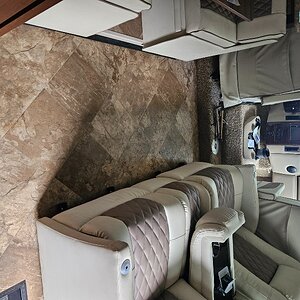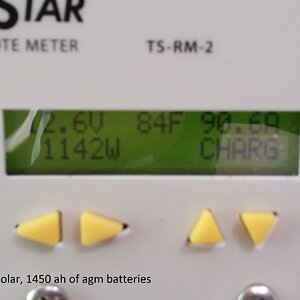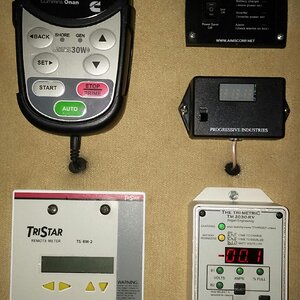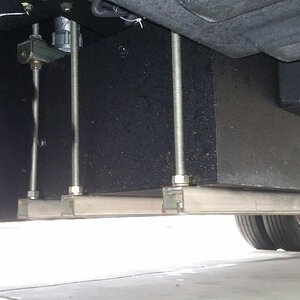Navigation
Install the app
How to install the app on iOS
Follow along with the video below to see how to install our site as a web app on your home screen.
Note: This feature may not be available in some browsers.
More options
Style variation
Welcome to RVForums.com
- Register now and join the discussion
- Friendliest RV Community on the web
- Modern site for PC's, Phones, Tablets - no 3rd party apps required
- Ask questions, help others, review campgrounds
- Get the most out of the RV Lifestyle
- Invite everyone to RVForums.com and let's have fun
- Commercial/Vendors welcome
You are using an out of date browser. It may not display this or other websites correctly.
You should upgrade or use an alternative browser.
You should upgrade or use an alternative browser.
Couple of newbi questions.
- Thread starter PapaRed1
- Start date
Neal
Administrator
- Joined
- Jul 27, 2019
- Messages
- 13,840
- Location
- Midlothian, VA
- RV Year
- 2017
- RV Make
- Newmar
- RV Model
- Ventana 4037
- RV Length
- 40' 10"
- Chassis
- Freightliner XCR
- Engine
- Cummins 400 HP
- TOW/TOAD
- 2017 Chevy Colorado
- Fulltimer
- No
Welcome to RVForums @PapaRed1
Re: 1 - What type of generator are you using? Pictures?
Re: 2 - This typically will occur if filling above the inlet line near the top of the tank. Try only filling to about the 90% point. There are things you can do to prevent siphoning but it would be best to see pictures of your fresh tank configuration first.
Re: 1 - What type of generator are you using? Pictures?
Re: 2 - This typically will occur if filling above the inlet line near the top of the tank. Try only filling to about the 90% point. There are things you can do to prevent siphoning but it would be best to see pictures of your fresh tank configuration first.
It is a fiman generator very similar to a champion. Looks almost like one you'd see at a construction site just much quiter. My setup is in storage so no pic available
As far as my rank it is enclosed so pics would be difficult.what I can tell you us I filled my tank and when I got to my site my tank was down to a third. Water came out the overflow on every hill and turn.
As far as my rank it is enclosed so pics would be difficult.what I can tell you us I filled my tank and when I got to my site my tank was down to a third. Water came out the overflow on every hill and turn.
RandyB
Retired
- Joined
- Nov 15, 2019
- Messages
- 459
- Location
- Portage, MI
- RV Year
- 2017
- RV Make
- Newmar
- RV Model
- Ventana LE 4037
- RV Length
- 40' 11"
- TOW/TOAD
- 2021 Chevy Trailblazer
- Fulltimer
- No
Fresh water tank anti-siphon
Without seeing or knowing about your situation, I have made a very generic sketch of a typical fresh water tank overflow.
1. Notice that the overflow tube enters the tank at the top. Depending on how talented and how hurried the installer is, the length of the overflow into the tank and therefore into the surface of the water really matters.
2. There is most likely a duckbill valve under the RV floor, which is there to allow water out, but nothing in. Somewhat like a check valve, but mostly for dirt and bugs. That item should stay in place.
3. What many, many owners have done is illustrated on the right. When it is accessible, the elbow is removed, a tee put in it's place, a tall standpipe is added and the end is capped with a venting cap. Some have used just a hole, others have attached a tube. The whole point of the vent hole is to break the suction of the water as is sloshes out of the tank and then down the pipe. The downward flow is creating a suction that continues to draw water until the water level is below the overflow pipe in in the tank even after the sloshing has stopped. The added stand pipe should be as tall as possible to allow some sloshing up the pipe, but not out the vent hole. Note: the addition of the tee can be in place of either elbow.
Remember: this is the fresh water tank. If you are drinking or cooking with this water, protect it in what you do.

Please all new members, use the signature line for identifying your RV, Toad or whatever you are inquiring about. It helps us know what you are working on and can make specific recommendations. Click on your name to access your account and scroll down to "signature". It will show up just like mine, below.
Without seeing or knowing about your situation, I have made a very generic sketch of a typical fresh water tank overflow.
1. Notice that the overflow tube enters the tank at the top. Depending on how talented and how hurried the installer is, the length of the overflow into the tank and therefore into the surface of the water really matters.
2. There is most likely a duckbill valve under the RV floor, which is there to allow water out, but nothing in. Somewhat like a check valve, but mostly for dirt and bugs. That item should stay in place.
3. What many, many owners have done is illustrated on the right. When it is accessible, the elbow is removed, a tee put in it's place, a tall standpipe is added and the end is capped with a venting cap. Some have used just a hole, others have attached a tube. The whole point of the vent hole is to break the suction of the water as is sloshes out of the tank and then down the pipe. The downward flow is creating a suction that continues to draw water until the water level is below the overflow pipe in in the tank even after the sloshing has stopped. The added stand pipe should be as tall as possible to allow some sloshing up the pipe, but not out the vent hole. Note: the addition of the tee can be in place of either elbow.
Remember: this is the fresh water tank. If you are drinking or cooking with this water, protect it in what you do.
Please all new members, use the signature line for identifying your RV, Toad or whatever you are inquiring about. It helps us know what you are working on and can make specific recommendations. Click on your name to access your account and scroll down to "signature". It will show up just like mine, below.
Last edited:
Kevin D Pem
RVF 5K Club
- Joined
- Jul 29, 2020
- Messages
- 5,274
- Location
- AZ
- RV Year
- 1984
- RV Make
- Alpinelite
- RV Length
- 26'
- TOW/TOAD
- 2016 Ram 1500
- Fulltimer
- Yes
Nomadwannabe
RVF Newbee
- Joined
- Oct 17, 2020
- Messages
- 2
- Location
- Port orchard wa
- RV Year
- 2018
- RV Make
- Forest river
- RV Model
- Cardinal luxury 5er
- RV Length
- 37
Similar threads
- Locked
- Replies
- 14
- Views
- 815
- Replies
- 17
- Views
- 650
- Replies
- 5
- Views
- 402
- Replies
- 4
- Views
- 347
- Replies
- 9
- Views
- 821
Latest resources
-
-
Trueline Leveling System (Valid Air)Operation & Service Manuals for the Valid Air leveling system
- Jim
- Updated:
-
-
Notes on the Electrical Systems of the Roadtrek Zion Family of RVsNotes on the Electrical Systems of the Roadtrek Zion Family of RVs
- dilbertjth
- Updated:
-












